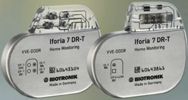
This is the thinnest
implantable cardioverter defibrillator (ICD) in Vietnam at 11 mm. With
is 1,73 Ah battery, the
nominal
service life is 9.7 years with a full set of diagnostics,
including
Home Monitoring and storage of 3 channels of cardiac electrogram with
pre-arrhythmia storage. Some competitors in their nominal service lives
do not include any pacing (we do 15% in the atrium, 50% in the
ventricle), pre-arrhythmia storage (can reduce longevity by up to 19%).
Some of the features of the Iforia 7 DR-T:
- MR conditional.
Full body scan with the appropriate leads.
- Home
monitoring ready.
- 40 J
maximum energy with shock waveform optimized for defibrillation
success. The 40J energy is available right from the first shock.
- ATP-one-Shot.
In the highest arrhythmia zone, the ventricular fibrillation zone, if
the rhythm is stable, a burst/ramp of pulses, an Anti-Tachycardia
Pacing (ATP) therapy can be used to try to stop the arrhythmia. If the
rythm is not stable, the ATP is skipped and a shock is delivered. With
stability checked prior to using ATP, this ensures that ATP is not
wasted on a rhythm that is unlikely to be terminated by the ATP. In
competing devices, the cardiologist has to decide apriori whether to
use ATP or not. With the Iforia, this is not necessary.
- Enhanced T
wave suppression. In past clinical studies, the main cause
of inappropriate therapies due to the ICD was the problem of oversensing of
the T wave leading to double counting of the rhythm. In the Iforia the
cardiologist can switch on Enhanced T wave suppression and a filter is
used to attenuate the Twave at the same time the automatic threshold is
altered to avoid detecting the T wave.
One of our competitor instead of getting to the root cause, filtering
the T wave, has chosen a software method to compare waveforms to
identify the Twave. Any post-processing run a chance of mistakenly
suppressing a valid signal. Better to take care of the problem at its root, in this case use a
filter to suppress the T wave!
- Ventricular
pacing reduction for patients with good atrio-ventricular
conduction. This is the IRS+
program discussed in the pacemaker section. Should reduce heart failure
in patients with good atrio-ventricular conduction.
- Automatic
adjustment of amplitude of ventricular pacing pulse.
- 24 minutes of
3 channel electrogram storage with 30 seconds of
pre-arrhythmia storage per episode, with high resolution and high fidelity signals.
Help troubleshoot the cause of the arrhythmia episode, and can be used
by the electrophysiologist to guide his search of the focus of the
arrythmia.
- Atrio-ventricular
discrimination algorithm. Smart Detection is the program
to determine whether an arrhythmia has a ventricular origin, and needs
to be treated, or a supraventricular origin, and needs to be ignored.
In the FDA clinical study back in 2001, it achieved a sensitivity close
to 100% (can detect all ventricular tachyarrhythmia) and a speficity of
94% (can detect most supraventricular tachyarrhythmia). One of the
reasons for choosing a dual chamber defibrillator is to avoid
inappropriate therapy due to supraventricular episodes. Then why not
choose the best?
Smart Detection is the only AV discrimination that has essentially not
been changed significantly over the past 18 years! Other alforithms
have undergone dramatic changes and typically have to tradeoff
sensitivity for specificity, but even then could not approach ours.
- Intrathoracic
impedance. Useful only when combined with Home Monitoring.
The impedance is measured 192 times/day to get an accurate picture of
the fluid accumulations in the lungs. The Home Monitoring clinical
specialist will be able to predict imminent episode of acute
decompensated heart failure from a combination of inputs. Our
competitors only measure 12-16 times/day!!
- Choice of DF-1
and DF-4 lead
connectors. Unlike other companies, you and
your cardiologist have a choice between using a shock lead with DF1 +
IS-1 connectors (Linox smart ProMRI) and one with a single DF-4
connector (Protego ProMRI). There are
advantages and disadvantages with each choice. But you do have a
choice! And you and your cardiologist can choose from single shock coil
or dual shock coils. We recommend the single shock coil since it is a
little bit easier to implant.With the Iforia ICD, with 40J shocks,
there is enough margin for the single coil shock.
The Linox smart ProMRI leads, with DF-1 + IS-1 connectors, and the
Protego ProMRI, with DF-4 connectors, are both 8F leads. They are shown
in the picture below.

- Reliable
leads. Biotronik is the only company not to have
had a single lead recalled in its 50+ year history!
Biotronik Iforia 7 DR-T,
Simply the best dual
chamber ICD system!
Biotronik
Iforia 7
VR-T DX
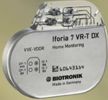
The
Iforia 7 VR-T DX is the high-end dual chamber ICD that just requires a single
lead, Linox smart ProMRI S DX. This single lead technology has been
available exclusively from Biotronik for the past 13 years.
With its
1,73Ah battery, the Iforia 7 VR-T DX has a nominal service life of 10.5
years!
Except for not been able to pace in the atrium, and thus is appropriate
only
for patients with a good sinus node, the Iforia 7 VR-T DX system has
exactly the same functionalities as the Iforia 7 DR-T above. Thus we
will not repeat the features of the Iforia 7 VR-T DX here.
With a
single lead, as opposed to a shock lead and an atrial lead, the Iforia
7 VR-T DX is easier to implant, and take up less space in the veins of
the patient.
The 8F Linox smart S DX lead is pictured below.

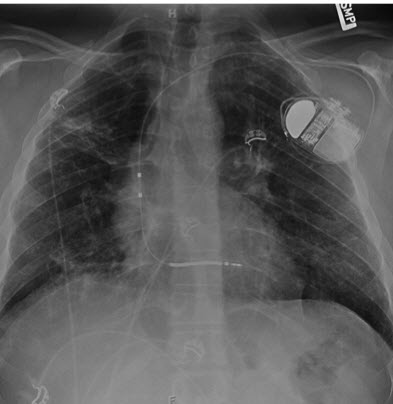 Implanted DX
system. A single lead for this dual chamber ICD!
Implanted DX
system. A single lead for this dual chamber ICD!
Notice the 2 rings in the
atrium.
Even though the Iforia 7 VR-T DX uses only 2 rings that do not need to
contact the atrium, excellent atrial signals can be recorded.
 3 channels
of stored IEGM in the Iforia 7 VR-T DX.
3 channels
of stored IEGM in the Iforia 7 VR-T DX.
Depicted is an episode of atrial flutter detected by the device but not
treated.
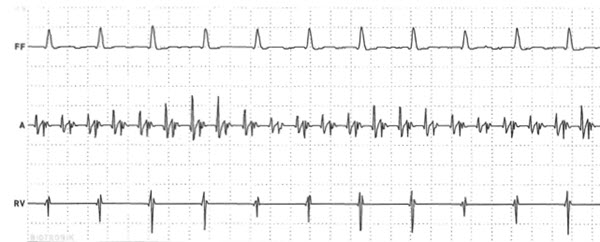
Episode of atrial fibrillation.
Initially cardiologists were concerned that a good atrial signal would
not be possible during atrial fibrillation. Notice the varying
amplitude, but the signal was adequate.
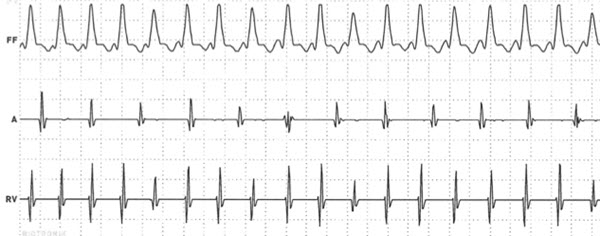
Episode of ventricular tachycardia
The
convenience of a single lead implant combined with the capabilities of
a dual chamber ICD has made the DX line of ICDs a great hit
in the US for new implants.
Biotronik
Iforia 7 VR-T
DX:
Implants
like a single chamber ICD, performs like a dual chamber
ICD.
Simply
the best single
lead dual chamber ICD system!
Medical tourism
If you are interesed
in being implanted one the above devices, we can help you make all
the arrangements. It will take approximately 2 weeks. Please feel free to contact us.
These Biotronik are covered by a worldwide warranty.






 This is the thinnest
implantable cardioverter defibrillator (ICD) in Vietnam at 11 mm. With
is 1,73 Ah battery, the nominal
service life is 9.7 years with a full set of diagnostics,
including
Home Monitoring and storage of 3 channels of cardiac electrogram with
pre-arrhythmia storage. Some competitors in their nominal service lives
do not include any pacing (we do 15% in the atrium, 50% in the
ventricle), pre-arrhythmia storage (can reduce longevity by up to 19%).
Some of the features of the Iforia 7 DR-T:
This is the thinnest
implantable cardioverter defibrillator (ICD) in Vietnam at 11 mm. With
is 1,73 Ah battery, the nominal
service life is 9.7 years with a full set of diagnostics,
including
Home Monitoring and storage of 3 channels of cardiac electrogram with
pre-arrhythmia storage. Some competitors in their nominal service lives
do not include any pacing (we do 15% in the atrium, 50% in the
ventricle), pre-arrhythmia storage (can reduce longevity by up to 19%).
Some of the features of the Iforia 7 DR-T:

 The
Iforia 7 VR-T DX is the high-end dual chamber ICD that just requires a single
lead, Linox smart ProMRI S DX. This single lead technology has been
available exclusively from Biotronik for the past 13 years.
The
Iforia 7 VR-T DX is the high-end dual chamber ICD that just requires a single
lead, Linox smart ProMRI S DX. This single lead technology has been
available exclusively from Biotronik for the past 13 years. 



